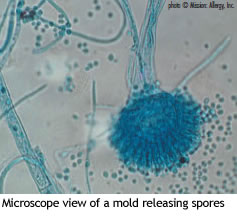Mold Allergy
If you have a mold allergy, it is important that you reduce your exposure. Exposure to mold allergens can occur both indoors and out of doors.
What is mold?
 Molds are microscopic fungal organisms. They grow as networks of interlocking filaments that spread on and into organic matter, leading to its decomposition. When clusters of these filaments become large enough, they are visible as fuzzy growths of mold or mildew. Bread mold is a familiar example.
Molds are microscopic fungal organisms. They grow as networks of interlocking filaments that spread on and into organic matter, leading to its decomposition. When clusters of these filaments become large enough, they are visible as fuzzy growths of mold or mildew. Bread mold is a familiar example.
Mold lives by secreting enzymes that break down the organic matter on which the mold is living, making it available as a nutrient for the mold. This breaking-down action is what makes mold damaging to household items such as paper, fabric or leather. Molds reproduce by forming spores, which travel through the air, settle on other plant or animal organic material, and grow into new clusters of filaments. The mold spores travel over large distances, and are often more numerous than the pollen grains of plants. Proteins in the secretions of the mold filaments, and possibly in the mold spores, are capable of causing allergy in some people.
Where are molds found?
Molds are found primarily in warm, dark and damp locations. Unlike plants, which use energy from the sun to produce food, molds obtain their energy by digesting other organic matter. To do so, they need moisture. Molds grow out of doors, and, if the humidity is high enough, indoors as well. They do not have the clearly defined seasons that pollens do, but are at their peak during months of high humidity, and are absent in outdoor air only if there is snow on the ground. They can grow on grass and on the bark of trees, and are plentiful in fallen leaves and other decaying vegetation. Indoors, they live in areas of high humidity, such as basements or poorly ventilated bathrooms.
What can be done to decrease exposure to mold?
Clean Your Home
-
Use diluted bleach to eliminate visible mold growth in showers and on shower curtains.
-
Avoid carpets in bathrooms, or use only washable throw rugs.
-
Remove any carpeting that has been installed directly on basement concrete floors. Use wipeable, vapor-barrier materials, such as tile or vinyl flooring. Mold-allergic people should not sleep in basement level bedrooms.
Control Your Air
-
Keep humidity under 50% by using air conditioning — possibly supplemented with dehumidifiers — in the summer. Use a gauge to measure indoor humidity. Small air dryers may be used to prevent mold growth in closets.
-
Avoid over-humidification. Either do not use a humidifier in the winter, or if you do, limit its output so that humidity remains under 50%. Use only humidifiers that have a heating element that prevents mold from growing in the unit itself.
-
Allow moisture to escape from the home. Ventilate the shower and cooking areas. Vent your clothes dryer to the outdoors. Open windows when outside humidity is low.
-
Do not store firewood indoors, and avoid live Christmas trees. Do not repot plants indoors. Mold lives on the bark of trees and in soil.
Avoid Outdoor Exposure
-
Avoid greenhouses, antique shops, summer cottages, and musty hotel rooms.
-
Wear a facemask, and possibly goggles, if you must cut grass, rake leaves, work in a barn, or be exposed to compost.
Previous: 3) Animal Dander Allergy
Next: 5) Pollen Allergy
Related Allergy Products
Mission: Allergy's helpful and knowledgeable customer service representatives are available to answer your questions or to take your order Monday-Friday 8:30am-5pm ET. Please call us toll-free at 877-662-5537.
